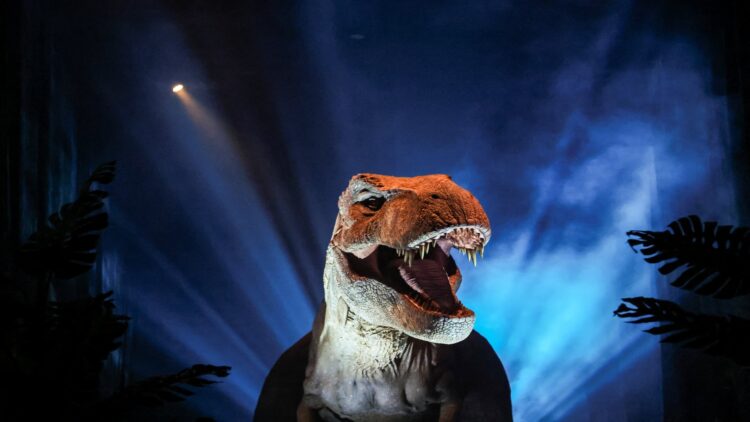Revolutionary new research has shattered long-held assumptions about dinosaur predation strategies, revealing that Tyrannosaurus rex’s bone-crushing bite force was just one of several successful evolutionary approaches to giant carnivory. This groundbreaking biomechanical analysis of 17 theropod species demonstrates that massive predatory dinosaurs didn’t follow a single evolutionary blueprint for success, instead developing diverse feeding strategies that allowed multiple giant carnivores to coexist without direct competition.
Diverse Predatory Strategies
Tyrannosaurus subdued prey with raw power, using bone-crushing bite force. But other meat-eating dinosaurs that rivaled T. rex in size used different approaches. Giganotosaurus relied more on slashing and ripping flesh. And the long and narrow snout of Spinosaurus was well-adapted for catching fish.
Researchers have documented the feeding biomechanics of meat-eating dinosaurs in a comprehensive analysis of the skull design and bite force of 17 species that prowled the landscape at various times from the dawn to the twilight of the age of dinosaurs.
The study found that Tyrannosaurus possessed by far the highest estimated bite force, with a heavily reinforced skull and massive jaw muscles. But it showed that other dinosaur predators evolved successful approaches to bringing down prey even without matching the T. rex chomp.
Evolutionary Adaptations
“Some, like T. rex, reinforced the skull to tolerate extremely high bite forces and the associated skull stresses. Others, like Allosaurus or Spinosaurus, went with lighter or possibly flexible builds that spread out stress in different ways. There’s no single ‘correct’ way to be a giant meat-eater, and that’s the point,” Rowe added.
The study focused on species within the group, or clade, called theropods that includes the meat-eating dinosaurs. They ran from Herrerasaurus, which lived in Argentina about 230 million years ago and is one of the earliest-known dinosaurs, all the way to T. rex, which was present in western North America when an asteroid struck Earth 66 million years ago and ended the age of dinosaurs.
Skull Strength Evolution
The early theropods examined in the study such as Herrerasaurus, which lived during the middle of the Triassic Period, and Dilophosaurus, which lived early in the Jurassic Period, exhibited much lower stress resistance than their later counterparts. They were lightly built dinosaurs and not well adapted to high bite forces, Rowe said.
The increase in bite force and skull strength unfolded gradually over time, reaching its apex with Tyrannosaurus and its close relatives in a lineage called tyrannosaurs such as Daspletosaurus and Albertosaurus, which like T. rex appeared late in the Cretaceous Period.
“In tyrannosaurs, there’s a big jump in skull strength and bite mechanics, coinciding with deeper skulls, more robust bone architecture and changes in jaw muscle attachment. So the ramp-up wasn’t immediate. It evolved over time and in certain lineages more than others,” Rowe said.
Size vs. Strategy
Tyrannosaurus, Giganotosaurus and Spinosaurus were three of the largest theropods, but their skulls were quite different. Perhaps the largest-known Tyrannosaurus is a specimen named Sue at the Field Museum in Chicago, at 40-1/2 feet (12.3 meters) long. Giganotosaurus and Spinosaurus rivaled T. rex in size.
Giganotosaurus lived in Argentina in the middle of the Cretaceous, while Spinosaurus inhabited North Africa at around the same time, both predating Tyrannosaurus by roughly 30 million years.
“Giganotosaurus was large, but its skull wasn’t built for the same kind of high-force feeding as T. rex. Spinosaurus had a long, narrow snout, which is consistent with a diet focused on fishing, though we have fossilized evidence that it ate other animals, such as pterosaurs,” Rowe said.
This revolutionary study fundamentally transforms our understanding of dinosaur predation by revealing that evolutionary success came through specialized diversity rather than brute force dominance. The research proves that giant carnivorous dinosaurs achieved apex predator status through multiple biomechanical pathways, each perfectly adapted to specific ecological niches and hunting strategies.
GCN.com/Reuters.


